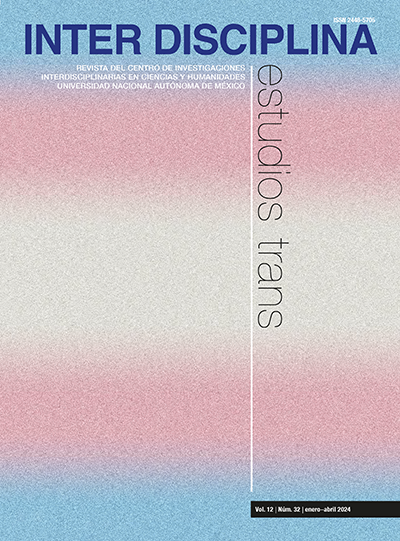¿Por qué es necesario eliminar la categoría sexo del ámbito biomédico? Hacia la noción de bioprocesos en la era posgenómica
Contenido principal del artículo
Resumen
La categoría sexo suele remitir a la idea de variables pre-sociales, es decir, desvinculadas del ambiente. Al mismo tiempo, se las interpreta fundamentales para acceder a una mejor comprensión respecto de las prevalencias, el desarrollo y el tratamiento de enfermedades. En este trabajo, argumento que tal caracterización supone una serie de sesgos que derivan de una lectura mecanicista sobre los procesos de diferenciación sexual, por un lado, la enfermedad, por otro y de manera confluente, respecto de la relación sexo-prevalencia. Con dicho fin, mostraré que ni la mayoría de las variables consideradas de relevancia clínica, ni sus variabilidades, son definidas por los atributos que asociamos a la categoría sexo. Por eso propondré que en la era posgenómica resulta necesario desplazar dicha categoría por la noción de bioprocesos. Este desplazamiento sugiere que la plasticidad que nos caracteriza desde la ontogenia deja sin efecto la dicotomía sexo-género, puesto que resulta implausible rastrear atributos biológicos pre-sociales, sobre los que finalmente cobraría inteligibilidad la propia noción de sexo. Posteriormente, recuperaré la idea de clases prácticas para considerar que, combinándola con la noción de bioprocesos, las variables biomédicas deben ser situadas y específicas, ajustadas al estudio de interés. Mostraré que algunas de las implicancias del desplazamiento que propongo suponen diluir valores cisnormativos, que marginalizan las corporalidades trans.
Descargas
Detalles del artículo
Citas en Dimensions Service
Citas
Ciccia, L. 2019. La categoría mujer en la investigación biomédica: el caso de la salud cardiovascular en clínicas mexicanas de cardiología: enfermedades cardiovasculares en la mujer. En Mujer y salud, cap. 2, vol. 2. Ciudad de México: Planeación y Desarrollo Editorial, S. A., de C. V., ISBN 978-607-8151-76-9 (Vol. 2).
Ciccia, L. 2021a. ¿Dimorfismo sexual o diferencias biológicas generizadas? Una reinterpretación de las categorías de sexo y de género en el ámbito biomédico. Revista Bioética CFM, 29(1): 66-75, Brasil. https://doi.org/10.1590/1983-80422021291447.
Dupré, J. 2018. Processes, organisms, kinds and the inevitability of pluralism. En Bueno, O., Chen, R., Fagan, M. (eds.), Individuation, process, and scientific practices. Oxford: Oxford Scholarship Online, cap. 2. https://doi.org/10.1093/oso/9780190636814.001.0001. https://www.researchgate.net/publication/ 305730344_Processes_Organisms_Kinds_and_the_Inevitability_of_Pluralism. (Consultado, enero 23, 2021).
Fox Keller, E. 1991. Reflexiones sobre género y ciencia. Valencia: Alfons el Magnánim.
Franklin-Hall, L. 2020. The animals sexes as historical explanatory kinds. En Dasgupta, S., Ravit Dotan, R., Weslake, B. (eds.), Current controversies in philosophy of science. Routledge, 177-197.
Frost, S. 2020. The attentive body: how the indexicality of epigenetic process enriches our understanding embodied subjectivity. Body and Society, 26(4): 3-34. https://doi.org/10.1177/1357034X20940778.
Guerrero, S. 2022. Debates metafísicos en torno al sexo, esencias, clases naturales y fronteras. En Guerrero Mc Manus, S., Ciccia, L. (comps.), Materialidades semióticas. Ciencia y cuerpo sexuado. Ciudad de México: CEIICH, UNAM, 21-46.
Haraway, D. 1995. Ciencia, ciborgs y mujeres, la reinvención de la naturaleza. Madrid: Ediciones Cátedra, 222 pp.
Hines, M. 2020. Neuroscience and sex/gender: looking back and forward. The Journal of Neuroscience, 40(1): 37-43, enero, Yale. https://doi.org/10.1523/JNEUROSCI.0750-19.2019.
Hyde, J., Bigler, R., Joel, D., Charlotte, C. T., Van Anders, S. 2019. The future of sex and gender, psychology: Five challenges to the gender binary. APA Psycnet, American Psychologist Association, 74(2): 171-193. https://doi.org/10.1037/amp0000307.
Joel, D., García-Falgueras, A., Swaab, D. 2019. The complex relationships between sex and the brain. The Neuroscientist, 26(2): 156-169. https://doi.org/10.1177/1073858419867298.
Kaiser, A. 2016. Sex/gender matters and sex/gender materialities in the brain. En Pitts-Taylor, V. (ed.), Mattering: Feminism, science, and materialism, vol. 1. Nueva York y Londres: New York University Press, cap 7, 122-139.
Karkazis, K., Jordan-Young, R., Davis, G., Camporesi, S. 2012. Out of bounds? A critique of the new policies on hyperandrogenism in elite female athletes. Am J Bioeth, 12(7): 3-16. https://doi.org/10.1080/15265161.2012.680533.
Krieger, N. 2001. A glossary for social epidemiology. J Epidemiol Community Health. 55(10): 693-700. https://doi.org/10.1136/jech.55.10.693. (Consultado, mayo 21, 2020).
Krieger, N., Jahn, J. L., Waterman, P. D. 2017. Jim Crow and estrogen-receptor-negative breast cancer: US-born black and white non-Hispanic women, 1992-2012. Cancer Causes Control, 28: 49-59. https://doi.org/10.1007/s10552-016-0834-2. (Consultado, mayo 21, 2020).
Méthot, P., Alizon, S. 2014. What is a pathogen? Toward a process view of host-parasite interactions. Virulence, 5(8): 775-785. https://doi.org/ 10.4161/21505594. 2014.960726.
Pérez, D., Ciccia, L. 2019. Natural kinds, normative kinds, and human behavior. Filosofía Unisinos, São Leopoldo, 20(3): 256-267. https://doi.org/10.4013/fsu.2019.203.04.
Pitts-Taylor, V. (ed.), Mattering: Feminism, science and materialism, vol. 1. Nueva York y Londres: New York University Press, 313 pp.
Richardson, S., Reiches, M., Shattuck-Heidorn, H., LaBonte, M. L., Consoli, T. 2015. Opinion: Focus on preclinical sex differences will not address women’s and men’s health disparities. PNAS, 112(44): 13419-13420. https://doi.org/10.1073/pnas.1516958112.
Rippon, G., Eliot, L., Genon, S., Joel, D. 2021. How hype and hyperbole distort the neuroscience of sex differences. PLoS Biol, 19(5). https://doi.org/10.1371/journal.pbio.3001253.
Rushovich, T. et al. 2021. Sex disparities in COVID-19 mortality vary across US racial groups. J Gen Intern Med, 36: 1696-1701. https://doi.org/10.1007/s11606-021-06699-4. DOI: 10.1007/s11606-021-06699-4.
Van Anders, S. et al. 2015. Effects of gendered behavior on testosterone in women and men. PNAS, 112(45): 13805-13810. https://doi.org/10.1073/pnas.1509591112.
Varga, S. 2018. “Relaxed” natural kinds and psychiatric classification. Biol & Biomed Sci, 72: 49-54. https://doi.org/10.1016/j.shpsc.2018.10.001.
Zachar, P. 2015. Psychiatric disorders: natural kinds made by the world or practical kinds made by us? World Psychiatry, 14(3): 288-290. https://doi.org/10.1002/wps.20240.

Esta obra está bajo una Licencia Creative Commons Atribución-NoComercial-SinDerivar 4.0 Internacional.





